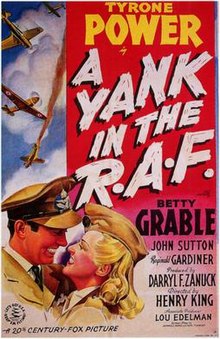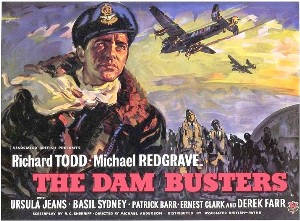
The Dam Busters is a 1955 British epic docudrama war film starring Richard Todd and Michael Redgrave, that was directed by Michael Anderson. Adapted by R. C. Sherriff from the books The Dam Busters (1951) by Paul Brickhill and Enemy Coast Ahead (1946) by Guy Gibson, the film depicts the true story of Operation Chastise when in 1943 the RAF's 617 Squadron attacked the Möhne, Eder, and Sorpe dams in Nazi Germany with Barnes Wallis's bouncing bomb.

Battle of Britain is a 1969 British war film directed by Guy Hamilton, and produced by Harry Saltzman and S. Benjamin Fisz. The film documents the events of the Battle of Britain. The film drew many respected British actors to accept roles as key figures of the battle, including Laurence Olivier as Air Chief Marshal Sir Hugh Dowding, Trevor Howard as Air Vice-Marshal Keith Park, and Patrick Wymark as Air Vice-Marshal Trafford Leigh-Mallory. It also starred Michael Caine, Christopher Plummer, and Robert Shaw as Squadron Leaders. The script by James Kennaway and Wilfred Greatorex was based on the book The Narrow Margin by Derek Wood and Derek Dempster.

633 Squadron is a 1964 war film directed by Walter Grauman and starring Cliff Robertson, George Chakiris, and Maria Perschy. The plot, which involves the exploits of a fictional World War II British fighter-bomber squadron, was based on the 1956 novel of the same name by former Royal Air Force officer Frederick E. Smith, which itself drew on several real RAF operations. The film was produced by Cecil F. Ford for the second film of Mirisch Productions UK subsidiary Mirisch Films for United Artists. 633 Squadron was the first aviation film to be shot in colour and Panavision widescreen.

133 Squadron RAF was one of the famous Eagle Squadrons formed from American volunteers serving with the Royal Air Force (RAF) during the Second World War.

The Way to the Stars is a 1945 Anglo-American black-and-white Second World War drama film made by Two Cities Films. The film was produced by Anatole de Grunwald, directed by Anthony Asquith, and stars Michael Redgrave, John Mills, Rosamund John, and Stanley Holloway. In the United States it was shortened by 22 minutes, and the shortened version was distributed by United Artists under the title Johnny in the Clouds.

Wing Commander Lance Cleo "Wildcat" Wade DSO, DFC & Two Bars was an American pilot who joined the Royal Air Force (RAF) during the Second World War and became a flying ace. He remained with RAF until his death in a flying accident in 1944 in Italy. He was described as a "distinguished American fighter ace who epitomized perhaps more than any other American airman the wartime accords between Britain and the United States".

Wing Commander Robert Roland Stanford Tuck, was a British fighter pilot, flying ace and test pilot. Tuck joined the Royal Air Force (RAF) in 1935 and first engaged in combat during the Battle of France, over Dunkirk, claiming his first victories. In September 1940 he was promoted to squadron leader and commanded a Hawker Hurricane squadron. In 1941–1942, Tuck participated in fighter sweeps over northern France. On 28 January 1942, he was hit by anti-aircraft fire, was forced to land in France, and was taken prisoner. At the time of his capture, Tuck had claimed 29 enemy aircraft destroyed, two shared destroyed, six probably destroyed, six damaged and one shared damaged.

No. 38 Squadron of the Royal Air Force was a bomber squadron formed in 1916 and was disbanded most recently in 1967.
The Royal Air Force (RAF) and Fleet Air Arm had included personnel from outside the United Kingdom from before the beginning of the Second World War, and many served in the Battle of Britain in summer 1940. Many of these volunteers were British subjects—thus, citizens—coming from territories that made up part of the British Empire. Additionally, a significant part was made up of refugees and exiles from German-occupied Europe and American emigrants.

Target for Tonight is a 1941 British World War II documentary film billed as filmed and acted by the Royal Air Force, all during wartime operations. It was directed by Harry Watt for the Crown Film Unit. The film is about the crew of a Wellington bomber taking part in a bombing mission over Nazi Germany. The film won an honorary Academy Award in 1942 as Best Documentary by the National Board of Review. Despite purporting to be a documentary there are multiple indicators that it is not quite as such: film shots include studio shots taken from the exterior of the aircraft looking into the cockpit whilst "in flight"; several stilted sections of dialogue are clearly scripted; on the ground shots of bombing are done using model trains; and several actors appear. The film does give a unique insight into the confined nature of the Wellington's interior and some of the nuances of day to day operation such as ground crew holding a blanket over the engine while it starts to regulate oxygen intake.

Squadron Leader Geoffrey Harris Augustus Wellum DFC was a British fighter pilot and author, best known for his participation in the Battle of Britain. Born an only child in Walthamstow, Essex, Wellum was educated at Forest School, Snaresbrook before serving in the RAF. After the war he remained in the RAF until 1961, and later ran a haulage business. In the mid-1980s he retired and moved to Mullion, Cornwall, where he wrote down his wartime memoirs. In 2002 these were published as First Light.
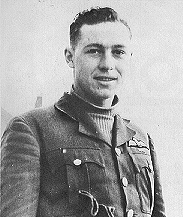
William Lidstone McKnight, was a Canadian aviator and flying ace of the Second World War. He was Canada's fifth-highest scoring ace of the war. McKnight joined the Royal Air Force (RAF) in early 1939 and served in No. 242 Squadron RAF during the final phase of the Battle of France, covering the Allied retreat from Brittany, and later the Battle of Britain.

Brian Carbury, was a New Zealand fighter ace of the Royal Air Force (RAF) during the Second World War. He was officially credited with destroying 15+1⁄2 German aircraft.
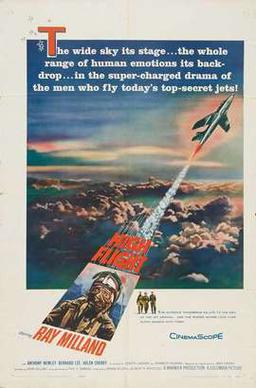
High Flight is a 1957 CinemaScope British cold war film, directed by John Gilling and starring Ray Milland, Bernard Lee and Leslie Phillips.

International Squadron is a 1941 American war film directed by Lewis Seiler and Lothar Mendes that starred Ronald Reagan, Olympe Bradna and in his final film, James Stephenson. The film is based on the Eagle Squadrons, American pilots who volunteered to fly for the Royal Air Force during World War II. International Squadron featured noted Hollywood pilot Paul Mantz who acted as the film's aerial coordinator and flew during the production.

Philip Hunter, DSO was a Royal Air Force pilot, squadron commander and a Second World War flying ace, awarded the Distinguished Service Order for leading the destruction of thirty-eight enemy aircraft in only two missions over the Dunkirk evacuation beaches in May 1940. He was killed in action leading his squadron during the Battle of Britain.
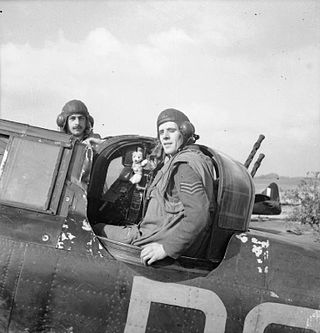
Edward Rowland Thorn,, also known as Roland Thorn, was a Royal Air Force pilot, squadron commander and a notable flying ace of the Second World War. He and his turret gunner shot down 12 enemy aircraft over the Dunkirk evacuation beaches and during the Battle of Britain. Thorn survived the war but was killed in a crash of an early jet fighter in 1946.
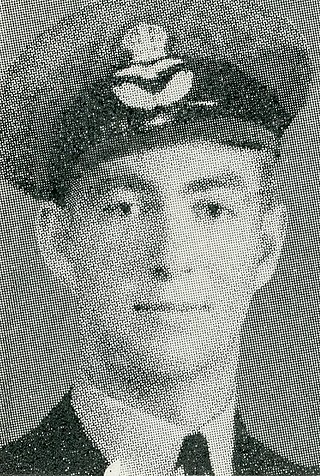
Richard Macklow Trousdale was a New Zealand flying ace of the Royal Air Force (RAF) during the Second World War. He was credited with at least six, possibly seven, aerial victories.

George Gribble, was a British flying ace of the Royal Air Force (RAF) during the Second World War. He was officially credited with the destruction of at least six German aircraft.

Harry Steere, was a British flying ace who served in the Royal Air Force (RAF) during the Second World War. He was credited with having shot down at least eleven aircraft.
